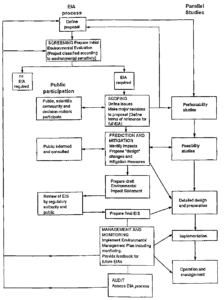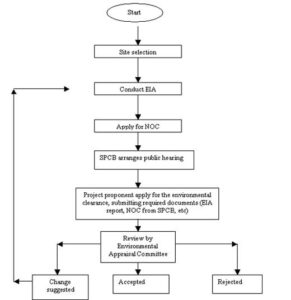Back to: Environmental Biology 400 Level
Welcome to class!
You’ve probably seen new roads, oil facilities, or real estate developments spring up around you. But before such projects begin, there’s an essential process they must go through—Environmental Impact Assessment (EIA). Today, you’ll learn not just what EIA is, but the exact procedure and steps followed to ensure that development doesn’t come at the cost of the environment.
EIA Procedure And Steps
Overview of the EIA Procedure

Environmental Impact Assessment is a step-by-step process used to predict and evaluate the potential environmental impacts of a proposed project before it starts. The goal is to identify possible risks early and propose solutions to prevent or reduce them. This procedure ensures that environmental concerns are considered in decision-making.
In Nigeria, this process is regulated under the Environmental Impact Assessment Act CAP E12 LFN 2004, and supervised by the Federal Ministry of Environment.
Step 1: Project Proposal
Every EIA begins with the project proponent (the developer) submitting a description of the proposed project to the authorities. This includes details such as location, purpose, scale, resources involved, and potential emissions or waste.
Step 2: Screening
Screening determines whether the project requires a full EIA. Projects with likely significant environmental impacts—like mining, oil drilling, highways, or large dams—automatically require EIA. Simpler projects might only need a Preliminary Environmental Report (PER).
Step 3: Scoping
At this stage, all possible environmental issues are identified and prioritised. What should the assessment focus on? Air pollution? Water contamination? Displacement of communities? This helps narrow down the assessment to the most significant concerns.
Step 4: Baseline Data Collection
Before assessing impacts, information about the current state of the environment in the project area is collected. This includes air and water quality, soil condition, wildlife presence, land use, and socio-economic factors. Think of it as taking a “before” picture to compare with the “after” effects of the project.
Step 5: Impact Prediction and Evaluation
Now the real analysis begins. Environmental scientists and consultants predict what will happen if the project goes ahead. Will it cause deforestation? Increase flooding? Harm biodiversity? Both positive and negative impacts are considered here.
Step 6: Mitigation Measures
This is where solutions are suggested to reduce or eliminate the negative impacts. For example, using solar power to reduce emissions, or creating artificial wetlands to treat wastewater before it enters rivers.
Step 7: Preparation of the EIA Report
All findings, data, and recommendations are compiled into an Environmental Impact Statement (EIS), which is submitted to the Ministry of Environment. It should be clear, detailed, and transparent.
Step 8: Public Participation and Review
Community members, experts, and other stakeholders are invited to review the EIA report. This is often done through public hearings, media notices, or community outreach. Their feedback can shape the final decision.
Step 9: Decision-Making
Based on the EIA report and public feedback, the authorities either approve the project (with or without conditions), request revisions, or reject it altogether. Approval often comes with a certificate and a list of compliance conditions.

Step 10: Monitoring and Compliance
After the project begins, it must be continuously monitored to ensure it’s following all environmental guidelines. Monitoring includes checking pollution levels, habitat protection, and how well mitigation measures are working.
Summary
- EIA is a formal process that evaluates the environmental impacts of development before they begin.
- Key steps include project proposal, screening, scoping, data collection, impact analysis, and mitigation.
- A detailed EIA report is prepared and reviewed by the public and government authorities.
- Final approval is given based on evidence and public input.
- Monitoring ensures compliance and protects long-term environmental health.
Evaluation
- What is the main goal of the EIA process?
- Describe what happens during the scoping step.
- Why is baseline data important in an EIA?
- Mention two types of mitigation measures a developer might propose.
- What role does public participation play in the EIA process?
Amazing job staying with this! By understanding the EIA procedure, you’re gaining the tools to shape development in a way that balances progress with protection. Keep growing your skills and never forget—Afrilearn is proud to help you become a future environmental leader. Let’s keep going!
